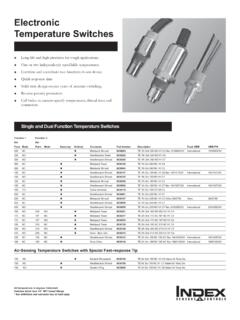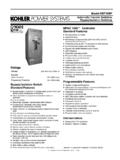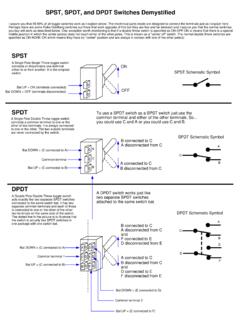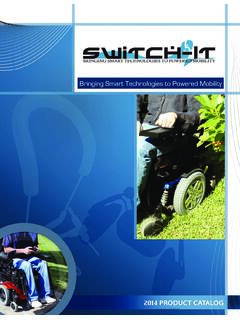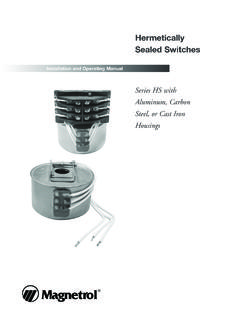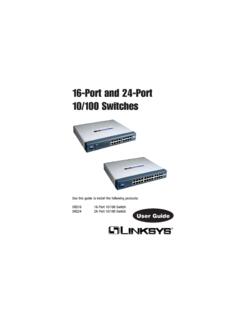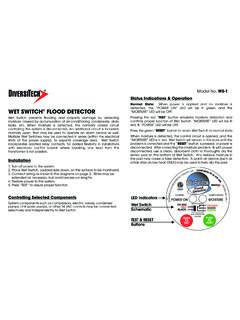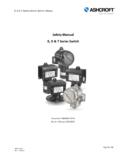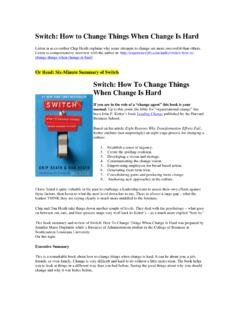Transcription of Wireless Lighting Control On/Off Relay Switch and 3-Way ...
1 GE SmartHome Wireless Lighting ControlOn/Off Relay Switchand 3-Way Switch Kit45637 the On/Off status of permanently installed Lighting , fans and more! 2012 JASCOMade in China4 IntroductionThank you for your purchase of a GE Z-Wave Control device. Z-Wave technology is designed to automate Lighting /home Control and provide easy remote operation of all your Z-Wave enabled de-vices. The GE Z-Wave product family includes a variety of devices to Control Lighting in your home. It is up to you whether you want to Control one room or your entire house and whether you want to do it all now or start with one room and add more over Switch is one component of a Z-Wave Control system and is designed to work with all other Z-Wave enabled devices in a home Control network.
2 It will also act as a Wireless repeater to insure that commands intended for another device in the network are received, thereby extending the range of the Wireless Control -ler. Z-Wave devices of other types and brands can be added to the system and will also act as range extenders if they support this function of repeating the signal received to other nodes in the system. CAUTIONThis device is intended for installation in accordance with the National Electric Code and local regulations in the United States, or the Canadian Electrical Code and local regulations in Canada. If you are unsure or uncomfortable about performing this installation consult a qualified Switch is designed for use only with permanently installed fixtures.
3 The device controlled by this Z-Wave Switch must not exceed 600 watts (Incandescent); 15 Amps, 1800W (Resistive); or HP (Motor). NOT FOR USE WITH MEDICAL OR LIFE SUPPORT EQUIPMENTZ-Wave enabled devices should never be used to supply power to or Control the On/Off status of medical and/or life support equipment! There are no user serviceable parts in this unit. Z-Wave CertifiedWireless Lighting ControlOn/Off Relay Switchand 3-Way Switch Kit5 WARNING RISK OF FIRE RISK OF ELECTRICAL SHOCK RISK OF BURNSC ontrolling Appliances:Exercise extreme caution when using Z-Wave devices to Control appliances. Operation of the Z-Wave device may be in a different room than the controlled appliance, also an uninten-tional activation may occur if the wrong button on the remote is pressed.
4 Z-Wave devices may automatically be powered on due to timed event programming. Depending upon the ap-pliance, these unattended or unintentional operations could possibly result in a hazardous condition. For these reasons, we recommend the following:1. Assign Z-Wave controlled appliances to device numbers 10 18 on the GE remote. The likelihood of unintentionally turn-ing on the appliance will be reduced significantly because the Shift button will need to be pressed before pressing device numbers 10-18. 2. Z-Wave devices controlling appliances should be removed from All Control setting. Instructions on how to do this are included in the manual for your GE remote. 3. Do Not include Z-Wave devices in Groups or Scenes if they Control Do Not use Z-Wave devices to Control electric heaters or any other appliances which may present a hazardous condition due to unattended or unintentional or automatic power on Double check programs for accuracy before using RANGEThis device complies with the Z-Wave standard of open-air, line of sight transmission distances of 65 feet.
5 Actual performance in a home depends on the number of walls between the remote controller and the destination device, the type of construction and the number of Z-Wave enabled devices installed in the Control net-work. Most Z-Wave devices act as signal repeaters and multiple devices result in more possible transmission routes which helps eliminate RF dead-spots . 6 Things to consider regarding RF range: Each wall or obstacle ( : refrigerator, big screen TV, etc.) between the remote or Z-Wave device and the destination device will reduce the maximum range by approximately 25-30%. Brick, tile or concrete walls block more of the RF signal than walls made of wooden studs and plasterboard (drywall).
6 Wall mounted Z-Wave devices installed in metal junction boxes may suffer a significant loss of range (approximately 20%) since the metal box blocks a large part of the RF of Home Construction on Wireless Range Between Z-Wave Enabled DevicesNote: The distances shown in the table below are typical examples. Actual performance in your home will the Remote (or repeating Z-Wave module) to destination device:Type of ConstructionWood Frame with DrywallBrick, Tile or ConcretePlastic J-Boxes*Metal J-BoxesPlastic J-Boxes*Metal J-BoxesNumber of Walls or Obstacles0**100 80 100 80 170 56 60 48 249 39 36 29 334 27 21 17 * For Plug-in Modules or In-Wall Devices Installed in Plastic Junction Boxes** Line of Sight / no obstructionsPlease Note: Z-Wave home Control networks are designed to work properly alongside Wireless computer networks, Bluetooth and other or devices.
7 Some baby cams, Wireless video devices and older cordless phones using the 900 MHz frequency range may cause interference and limit Z-Wave functionality. Many 900 MHz products have a Switch to select channel A or B . You may find that one of these channels will cause less interference than the NOTE ABOUT 3-Way CIRCUITSThe term 3-Way circuit refers to a circuit with two switches and one load (light) like you find at the top and bottom of a stairway. There are many ways to physically wire a 3-Way circuit and it is important to understand how the circuit you wish to upgrade to Z-Wave Control is wired. Below is a description of a typical 3-Way of the ways to wire a two- Switch /one-load circuit is to route the incoming power through the first Switch , then to the second Switch and then to the load.
8 Although very common and by no means a standard, it is the easiest to convert to Z-Wave Control . With this type of circuit, Switch 1 is replaced by the Z-Wave auxiliary Switch and Switch 2 is replaced with the primary Z-Wave Switch . The auxil-iary Switch does not actually Control the power; instead, it sends a momentary voltage signal through the traveler wire to the primary Switch which in turn, controls the power to the load. Typical 3-Way circuit: Please consult an electrician if you have trouble identifying the type of wiring circuit you wish to convert or if you do not feel confident in your ability to convert the circuit to Z-Wave Switch may be used in new installations or to replace an existing wall Switch .
9 It may be used by itself for 2-way Control (one Switch & one load), with one 45610 Auxiliary Switch for 3-Way con-trol (two switches & one load) or with two 45610 Auxiliary switches for 4-way Control (three switches & one load). When used by itself for 2-way Control , please make sure that the screw terminal for the traveler wire is insulated (Do Not Remove the tape over the terminal if you are not using the traveler connection).Single Switch Wiring Schematic BlackWhiteSwitch 1 Switch 2 Colored (NOT GREEN)BlackBlackWhite (Neutral)Z-Wave 45609 Black (Line/Hot)Black (Load)Green (Ground)83-Way Wiring Schematic using one 45609 and one 45610 4-Way Wiring Schematic using one 45609 and two 45610 s White (Neutral)Z-Wave 45609 Black (Line/Hot)Black (Load)Green (Ground)Z-Wave 45610 Traveler - Colored (Not Green)White (Neutral)Z-Wave 45609 Black (Line/Hot)Black (Load)Green (Ground)Z-Wave 45610 Traveler - Colored (Not Green)Z-Wave 45610 Traveler - Colored (Not Green)Red - TravelerWhite - NeutralBlack Load (to light fixture)Green - GroundBlack Line / Hot (from breaker)
10 9 Single, Dual and Triple Gang Boxes When installing the 45609 in multiple gang boxes it may be necessary to break off one or both of the scored tabs on the front yoke. This does not affect the electrical rating of the 45609. WARNING - SHOCK HAZARDTurn OFF the power to the branch circuit for the Switch and Lighting fixture at the service panel. All wiring connections must be made with the POWER OFF to avoid personal injury and/or damage to the Shut off power to the circuit at fuse box or circuit Remove wall plate. ! Warning: Verify power is OFF to Switch box before continuing. 3. Remove the Switch mounting screws. 4. Carefully remove the Switch from the Switch box. DO NOT disconnect the There are five screw terminals on the 45609 Switch ; these are marked LINE (Hot), Neutral, LOAD, GROUND and TRAVELER.

